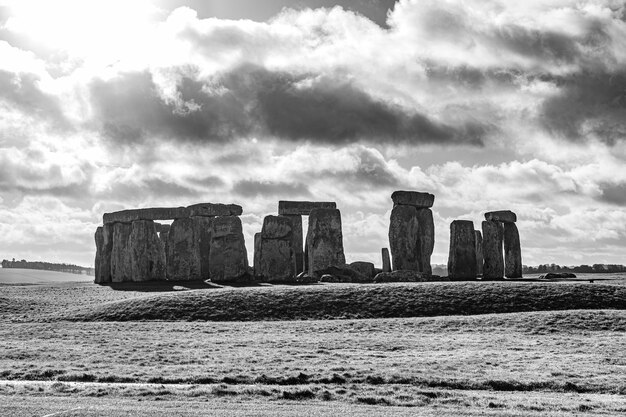

Stonehenge is a prehistoric monument located in Wiltshire, England.
It is estimated to have been constructed around 3000 BC to 2000 BC.
The monument is made up of massive standing stones, some weighing up to 25 tons.
Stonehenge was originally a burial ground for important individuals.
The purpose and meaning behind Stonehenge’s construction are still debated by archaeologists.
Stonehenge is aligned with the movements of the sun during the summer and winter solstices.
The monument attracts millions of visitors each year who come to witness its unique structure.
Archaeological findings around Stonehenge suggest it may have been a ceremonial site.
Stonehenge’s construction required immense planning and organization, considering the size and weight of the stones.
Stonehenge is believed to have taken several hundred years to complete.
The monument has undergone various changes and reconstruction throughout its history.
Stonehenge is a UNESCO World Heritage Site recognized for its cultural importance.
Some theories suggest that Stonehenge was used as an astronomical observatory.
Stonehenge is one of the most iconic and famous prehistoric sites in the world.
The stones used in Stonehenge are believed to have been transported from a quarry over 20 miles away.
The purpose of Stonehenge remains a mystery, adding to its intrigue and fascination.
Stonehenge’s construction demonstrates the advanced engineering skills of the ancient people who built it.
Stonehenge was likely a symbol of power and prestige for the community that created it.
Stonehenge’s positioning may have been significant in relation to the landscape and surrounding landmarks.
The monument’s design and layout are meticulously crafted, showcasing the attention to detail of its builders.
The stones at Stonehenge are arranged in various formations, such as concentric circles and horseshoes.
Stonehenge is associated with numerous myths, legends, and folklore.
The site’s atmosphere is often described as mystical and awe-inspiring.
Stonehenge’s purpose was likely multi-faceted, serving both practical and symbolic roles.
The stones at Stonehenge are made of a type of rock called bluestone, which originated in Wales.
Stonehenge has inspired countless artists, writers, and musicians throughout history.
Stonehenge is an enduring symbol of ancient Britain’s heritage and cultural significance.
The monument’s construction required the movement of thousands of tons of earth and stone.
Stonehenge is associated with the Druids, although evidence of their connection remains limited.
The stones at Stonehenge were placed in specific alignments to mark significant astronomical events.
Stonehenge’s precise purpose may never be fully understood, allowing for continued speculation and research.
The monument’s location and orientation may have served as a marker for seasonal changes and agricultural cycles.
Stonehenge’s significance stretches beyond its physical structure, symbolizing humanity’s curiosity and desire to explore the past.
The monument’s age and historical context contribute to its status as a cultural treasure.
Stonehenge’s enduring appeal is a testament to its timeless and enigmatic nature.
Stonehenge has been featured in numerous films, TV shows, and literature, cementing its place in popular culture.
The monument’s construction reflects the ingenuity and resourcefulness of the ancient people who built it.
Stonehenge’s preservation is an ongoing effort to ensure future generations can appreciate its historical value.
The origin of Stonehenge’s stones has sparked debates over the methods used to transport them to the site.
Stonehenge’s cultural significance extends beyond England, attracting visitors from all corners of the globe.
Stonehenge’s purpose may have evolved over time, adapting to the changing needs and beliefs of the community that used it.
The monument’s construction required a high level of mathematical and engineering knowledge.
Research and excavations at Stonehenge continue to uncover new insights into its construction and significance.
Stonehenge’s enduring legacy inspires awe and wonder about the capabilities of ancient civilizations.
Stonehenge’s enduring presence serves as a reminder of the passage of time and the resilience of human history.
Around the world, coffee enthusiasts enjoy Monin coffee concentrate since it is a multipurpose product. Conveniently combining…
The Importance of Choosing the Right Shower for Your Bathroom Renovating your bathroom can be…
Usain Bolt holds the record for the fastest 100-meter sprint in history.Bolt was named Sportsman…
Love is in the air... and it smells suspiciously like chocolate!Roses are red, violets are…
Life's a beach, take a picture and relax.Sun, sand, and salty kisses. That's what beach…
Hungary is home to the largest thermal water cave system in the world.The Rubik's Cube…